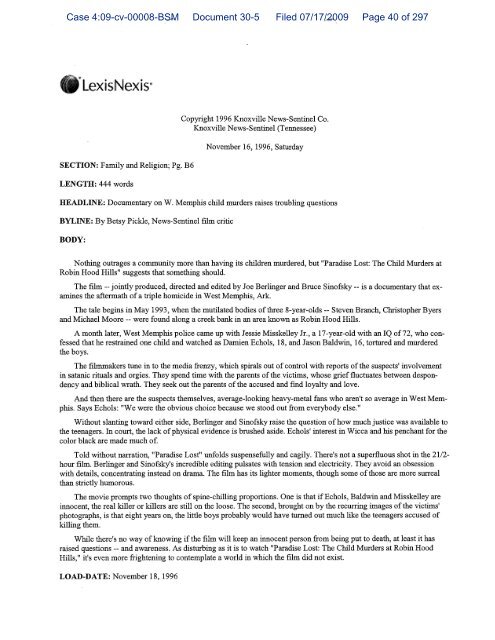EXHIBIT A-IOI - West Memphis Three Case - Document Archive
EXHIBIT A-IOI - West Memphis Three Case - Document Archive
EXHIBIT A-IOI - West Memphis Three Case - Document Archive
Create successful ePaper yourself
Turn your PDF publications into a flip-book with our unique Google optimized e-Paper software.
<strong>Case</strong> 4:09-cv-00008-BSM <strong>Document</strong> 30-5 Filed 07/17/2009 Page 40 of 297<br />
..,<br />
LexisNexis"<br />
SECTION: Family and Religion; Pg. B6<br />
LENGTH: 444 words<br />
Copyright 1996 Knoxville News-Sentinel Co.<br />
Knoxville News-Sentinel (Tennessee)<br />
November 16, 1996, Saturday<br />
HEADLINE: <strong>Document</strong>ary on W. <strong>Memphis</strong> child murders raises troubling questions<br />
BYLINE: By Betsy Pickle, News-Sentinel film critic<br />
BODY:<br />
Nothing outrages a community more than having its children murdered, but "Paradise Lost: The Child Murders at<br />
Robin Hood Hills" suggests that something should.<br />
The film -- jointly produced, directed and edited by Joe Berlinger and Bruce Sinofsky -- is a documentary that examines<br />
the aftermath ofa triple homicide in <strong>West</strong> <strong>Memphis</strong>, Ark.<br />
The tale begins in May 1993, when the mutilated bodies ofthree 8-year-olds -- Steven Branch, Christopher Byers<br />
and Michael Moore -- were found along a creek bank in an area known as Robin Hood Hills.<br />
A month later, <strong>West</strong> <strong>Memphis</strong> police came up with Jessie Misskelley Jr., a 17-year-old with an IQ of72, who confessed<br />
that he restrained one child and watched as Damien Echols, 18, and Jason Baldwin, 16, tortured and murdered<br />
the boys.<br />
The filmmakers tune in to the media frenzy, which spirals out ofcontrol with reports ofthe suspects' involvement<br />
in satanic rituals and orgies. They spend time with the parents ofthe victims, whose grieffluctuates between despondency<br />
and biblical wrath. They seek out the parents ofthe accused and fmd loyalty and love.<br />
And then there are the suspects themselves, average-looking heavy-metal fans who aren't so average in <strong>West</strong> <strong>Memphis</strong>.<br />
Says Echols: "We were the obvious choice because we stood out from everybody else."<br />
Without slanting toward either side, Berlinger and Sinofsky raise the question ofhow much justice was available to<br />
the teenagers. In court, the lack ofphysical evidence is brushed aside. Echols' interest in Wicca and his penchant for the<br />
color black are made much of.<br />
Told without narration, "Paradise Lost" unfolds suspensefully and cagily. There's not a superfluous shot in the 21/2hour<br />
film. Berlinger and Sinofsky's incredible editing pulsates with tension and electricity. They avoid an obsession<br />
with details, concentrating instead on drama. The film has its lighter moments, though some ofthose are more surreal<br />
than strictly humorous.<br />
The movie prompts two thoughts ofspine-chilling proportions. One is that ifEchols, Baldwin and Misskelley are<br />
innocent, the real killer or killers are still on the loose. The second, brought on by the recurring images ofthe victims'<br />
photographs, is that eight years on, the little boys probably would have turned out much like the teenagers accused of<br />
killing them.<br />
While there's no way ofknowing ifthe film will keep an innocent person from being put to death, at least it has<br />
raised questions -- and awareness. As disturbing as it is to watch "Paradise Lost: The Child Murders at Robin Hood<br />
Hills," it's even more frightening to contemplate a world in which the film did not exist.<br />
LOAD-DATE: November 18,1996


